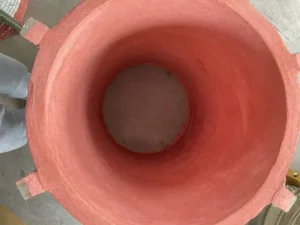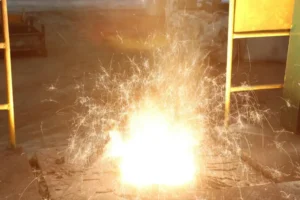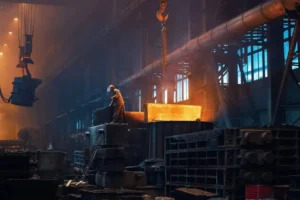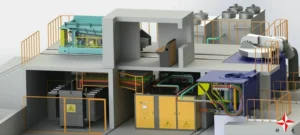По мере того, как мир ускоряется к чистоту, более устойчивая структура энергии, новые энергетические технологии развиваются беспрецедентными темпами. В этой волне энергетической революции, внешне традиционное промышленное устройство, тот индукционная печь, играет все более важную роль в таких ключевых областях, как материалы для аккумуляторов и материалы для хранения водорода., становясь “невидимый огонь” стимулирование развития новых энергетических технологий.
Включение батарей. Материалы, Преимущества индукционного спекания
От смартфонов до электромобилей, литий-ионные аккумуляторы сейчас повсюду. Основные характеристики этих батарей определяются материалами их катода и анода.. Качество этих материалов, по очереди, во многом зависит от критического этапа производства: спекание.
Спекание, простыми словами, это процесс нагревания порошкообразных материалов при высоких температурах для их уплотнения и формирования специфической кристаллической структуры.. Хотя при традиционном спекании часто используются печи сопротивления или газовые печи., Технология индукционного нагрева становится превосходной альтернативой благодаря своим значительным преимуществам.:
- Точный, Быстрый, и эффективный: Принцип индукционного нагрева предполагает использование переменного магнитного поля для создания вихревых токов внутри самого материала., вызывая это “самонагрев.” Этот метод очень быстрый, значительное сокращение производственных циклов. Что еще более важно, поскольку тепло генерируется непосредственно внутри материала, контроль температуры более точный и равномерный. Это позволяет избежать несоответствия температуры, обычного для традиционных печей, вызванного тепловым излучением и проводимостью., тем самым обеспечивая высокую однородность и превосходные электрохимические характеристики материалов аккумуляторов..
- Энергосберегающий и экологически чистый: Благодаря прямому внутреннему нагреву, Энергоэффективность индукционных печей намного превосходит эффективность традиционных печей сопротивления.. Это приводит к снижению энергопотребления и уменьшению выбросов углекислого газа., идеально соответствует философии зеленого и низкоуглеродного развития новой энергетической отрасли..
- Производство высокой чистоты Среда: Индукционный нагрев не требует горения, тем самым избегая загрязнения топливными примесями. Индукционная печь, работающая в вакууме или в определенной атмосфере, может обеспечить идеальную, чистая среда для спекания аккумуляторных материалов, особенно для тех, у кого требования к чрезвычайно высокой чистоте, например, к твердотельным электролитам.
Для аккумуляторных технологий следующего поколения, таких как твердотельные батареи, спекание их сердцевины в керамических электролитах требует еще более строгого контроля над температурой и атмосферой.. Точность и управляемость индукционного спекания являются идеальным решением., потенциально преодолеть ключевые технические узкие места в индустриализации твердотельных батарей.
Открывая ключ к водородной энергетике, Потенциал индукционных печей в подготовке материалов для хранения водорода
Водород провозглашается лучшим источником энергии в 21 веке., но это “Ахиллес’ каблук” как хранить и транспортировать его безопасно и эффективно. Материалы для хранения водорода, особенно гидриды металлов, считаются весьма перспективным решением.
Индукционные печи также показывают большие перспективы в приготовлении сплавов для хранения водорода.:
- Гомогенизация состава сплава: Многие высокоэффективные материалы для хранения водорода представляют собой сплавы, состоящие из нескольких металлических элементов.. Эффект электромагнитного перемешивания, возникающий при индукционной плавке, способствует тщательному перемешиванию расплавленных металлов., обеспечение однородного состава конечного сплава. Это приводит к более стабильным и повторяемым характеристикам хранения водорода..
- Приготовление специальных сплавов: Для некоторых металлов с высокими температурами плавления и высокой реакционной способностью., индукционная плавка может осуществляться в вакууме или защитной атмосфере.. Это эффективно предотвращает окисление и загрязнение материала., что делает его идеальным выбором для приготовления продуктов высокой чистоты., высокоэффективные сплавы для хранения водорода. Исследования показывают, что материалы для хранения водорода, приготовленные с использованием технологии вакуумной индукционной плавки, демонстрируют превосходную емкость хранения и производительность цикла..
- Эффективное и гибкое производство: Индукционные печи можно быстро запустить и остановить., возможность гибкой корректировки в зависимости от производственных потребностей. Это делает их очень подходящими как для мелкосерийного пробного производства во время R, так и для мелкосерийного пробного производства.&Фазы D и гибкие производственные требования будущего коммерческого производства.
Вызовы и перспективы на будущее
Хотя индукционные печи демонстрируют огромный потенциал в новой энергетике, их широкое внедрение все еще сталкивается с некоторыми проблемами. Например, изоляционные керамические материалы требуют непрямых методов индукционного нагрева., и первоначальные инвестиционные затраты на оборудование могут быть относительно высокими.
Однако, преимущества намного перевешивают недостатки. Поскольку технологии продолжают развиваться, эти проблемы постепенно преодолеваются. В будущем, Технология индукционного нагрева будет развиваться в сторону большего интеллекта и автоматизации. Интеграция с Искусственный интеллект (ИИ) и Интернет вещей (Интернет вещей) позволит осуществлять мониторинг в режиме реального времени и точный контроль процессов спекания и плавления., дальнейшее повышение качества продукции и эффективности производства.
Можно предвидеть, что с продолжающейся популяризацией транспортных средств на новых источниках энергии и постепенным развитием водородной энергетики, спрос на высокопроизводительные аккумуляторные материалы и материалы для хранения водорода будет стремительно расти. В этот момент, эффективный, точный, экологически чистые технологии индукционных печей, несомненно, будут играть незаменимую ключевую роль в производстве новых энергетических материалов., обеспечивая мощный и надежный “огонь печи” построить очиститель, более устойчивое энергетическое будущее.







